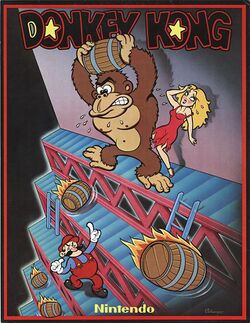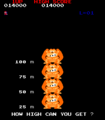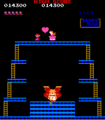(Added to Virtual Console category) |
BrownDerby (talk | contribs) mNo edit summary |
||
| (80 intermediate revisions by 27 users not shown) | |||
| Line 1: | Line 1: | ||
{{ | <div class="headerimage" style="background: #000;">[[File:Donkey Kong Header.png]]</div> | ||
{{ | {{Header Nav|game=Donkey Kong}} | ||
| | {{Game | ||
|developer=[[Nintendo]] | |completion=5 | ||
|image=Donkey Kong US arcade flyer.jpg | |||
|title=Donkey Kong | |||
|japanese=ドンキーコング | |||
|developer=[[Nintendo R&D1]], [[Coleco]] | |||
|publisher=[[Nintendo]] | |publisher=[[Nintendo]] | ||
| | |year=1981 | ||
| | |systems={{syslist|arcade|appleii|a8bit|a2600|a7800|cv|c64|vic20|ereader|gba|intellivision|msx|nes|fds|ti99|cpc|dos|zx|wii|3ds|wiiu|switch}} | ||
| | |ratings={{CERO|A}}{{ESRB|E}}{{PEGI|3}}{{OFLC|G}} | ||
|title1=Arcade Archives Donkey Kong | |||
|developer1=[[Nintendo]] | |||
|publisher1=[[Hamster Corporation]] | |||
|year1=2018 | |||
|systems1={{syslist|switch}} | |||
|genre=[[Action]] | |||
|players=1-2 | |players=1-2 | ||
| | |modes=[[Single player]], [[Multiplayer]] | ||
|followed by=[[Donkey Kong Jr.]] | |||
|series=Donkey Kong | |||
|series2=Arcade Archives | |||
|seriesDisambig=Donkey Kong | |||
|pcgamingwiki=Donkey Kong | |||
}} | }} | ||
{{ | {{game disambig||the 1994 remake for the Game Boy|[[Donkey Kong (Game Boy)]]}} | ||
{{marquee|DK Marquee.jpg}} | |||
[[ | '''Donkey Kong''' first arrived in the arcades in [[1981]] as the game that Shigeru Miyamoto designed to replace the ill-fated arcade game [[Radar Scope]]. It featured a mustachioed man in brightly colored overalls who would go on to achieve monumental fame and bring [[Nintendo]] a lot of fortune. Originally he was simply called Jumpman and was labeled a carpenter, he was eventually named {{c|Mario}} and identified as a plumber. | ||
When Donkey Kong became popular, [[Atari]] sought to buy the home rights to the game. But at that time, Coleco bid for the rights as well when trying to snag a killer launch title for their soon to be released [[ColecoVision]]. Coleco got the home cartridge rights while Atari ended up with the computer diskette rights. This arrangement worked out well until it backfired at the 1983 CES show, where Coleco presented their enhanced version of Donkey Kong for the Coleco ADAM computer. Atari, upset over the apparent breach of contract, ordered Nintendo to make Coleco shut down the display. | |||
When the [[Famicom]] launched in [[1983]], Nintendo provided their three biggest arcade hits as launch titles. Donkey Kong was an obvious choice. The Famicom conversion is a very close port of the original game with only minimally altered graphics, but sadly featuring the omission of the conveyor belt stage. Despite the missing stage, the remaining three stages make it in tact, and provide all of the same challenges found the arcade version. | |||
When the [[ | |||
==Story== | |||
Donkey Kong lays eyes on Mario's girlfriend Pauline and is instantly smitten, driving Donkey Kong to capture Pauline in his clutches and climb to the top of the construction site where Mario works. Mario is determined to get Pauline back, but Donkey Kong hurls barrels and employs fire to hinder the carpenter's efforts. Guide Mario through the gauntlet and up to the top before time and Pauline's patience runs out! | Donkey Kong lays eyes on Mario's girlfriend Pauline and is instantly smitten, driving Donkey Kong to capture Pauline in his clutches and climb to the top of the construction site where Mario works. Mario is determined to get Pauline back, but Donkey Kong hurls barrels and employs fire to hinder the carpenter's efforts. Guide Mario through the gauntlet and up to the top before time and Pauline's patience runs out! | ||
<gallery> | <gallery> | ||
File:Donkey Kong JP arcade flyer.jpg|Japanese flyer | |||
File:DK Title.png|Title screen | |||
File:DK Arcade.png|Intro screen | |||
File:Donkey Kong end.png|Ending cinematic | |||
</gallery> | </gallery> | ||
{{ToC}} | |||
{{Donkey Kong}} | |||
[[Category:Nintendo Research & Development 1]] | |||
[[Category:Coleco]] | |||
[[Category:Nintendo]] | |||
[[Category:Hamster Corporation]] | |||
[[Category: | |||
[[Category: | |||
[[Category: | |||
[[Category: | |||
[[Category:Action]] | [[Category:Action]] | ||
[[Category:Single player]] | [[Category:Single player]] | ||
[[Category: | [[Category:Multiplayer]] | ||
[[Category:MAME]] | |||
Latest revision as of 16:30, 19 June 2022
This is the first game in the Donkey Kong series. For other games in the series see the Donkey Kong category.

| Donkey Kong | |
|---|---|
| Developer(s) | Nintendo R&D1, Coleco |
| Publisher(s) | Nintendo |
| Year released | 1981 |
| System(s) | Arcade, Apple II, Atari 8-bit, Atari 2600, Atari 7800, ColecoVision, Commodore 64/128, Commodore VIC-20, e-Reader, Game Boy Advance, Intellivision, MSX, NES, Family Computer Disk System, TI-99/4A, Amstrad CPC, DOS, Sinclair ZX Spectrum, Wii, Nintendo 3DS, Wii U, Nintendo Switch |
| Followed by | Donkey Kong Jr. |
| Series | Donkey Kong, Arcade Archives |
| Japanese title | ドンキーコング |
|---|---|
| Genre(s) | Action |
| Players | 1-2 |
| Modes | Single player, Multiplayer |
| Rating(s) |
| Arcade Archives Donkey Kong | |
|---|---|
| Developer(s) | Nintendo |
| Publisher(s) | Hamster Corporation |
| Year released | 2018 |
| System(s) | Nintendo Switch |
- For the 1994 remake for the Game Boy, see Donkey Kong (Game Boy).
Donkey Kong first arrived in the arcades in 1981 as the game that Shigeru Miyamoto designed to replace the ill-fated arcade game Radar Scope. It featured a mustachioed man in brightly colored overalls who would go on to achieve monumental fame and bring Nintendo a lot of fortune. Originally he was simply called Jumpman and was labeled a carpenter, he was eventually named Mario and identified as a plumber.
When Donkey Kong became popular, Atari sought to buy the home rights to the game. But at that time, Coleco bid for the rights as well when trying to snag a killer launch title for their soon to be released ColecoVision. Coleco got the home cartridge rights while Atari ended up with the computer diskette rights. This arrangement worked out well until it backfired at the 1983 CES show, where Coleco presented their enhanced version of Donkey Kong for the Coleco ADAM computer. Atari, upset over the apparent breach of contract, ordered Nintendo to make Coleco shut down the display.
When the Famicom launched in 1983, Nintendo provided their three biggest arcade hits as launch titles. Donkey Kong was an obvious choice. The Famicom conversion is a very close port of the original game with only minimally altered graphics, but sadly featuring the omission of the conveyor belt stage. Despite the missing stage, the remaining three stages make it in tact, and provide all of the same challenges found the arcade version.
Story[edit]
Donkey Kong lays eyes on Mario's girlfriend Pauline and is instantly smitten, driving Donkey Kong to capture Pauline in his clutches and climb to the top of the construction site where Mario works. Mario is determined to get Pauline back, but Donkey Kong hurls barrels and employs fire to hinder the carpenter's efforts. Guide Mario through the gauntlet and up to the top before time and Pauline's patience runs out!
-
Japanese flyer
-
Title screen
-
Intro screen
-
Ending cinematic
Table of Contents
- Arcade
- Apple II
- Atari 8-bit
- Atari 2600
- Atari 7800
- ColecoVision
- Commodore 64/128
- Commodore VIC-20
- E-Reader
- Game Boy Advance
- Intellivision
- MSX
- NES
- Family Computer Disk System
- TI-99/4A
- Amstrad CPC
- DOS
- Sinclair ZX Spectrum
- Wii
- Nintendo 3DS
- Wii U
- Nintendo Switch
- 2018
- Games
- Guides at completion stage 5
- 1981
- Donkey Kong
- Arcade Archives
- Nintendo Research & Development 1
- Coleco
- Nintendo
- Hamster Corporation
- Action
- Single player
- Multiplayer
- MAME







